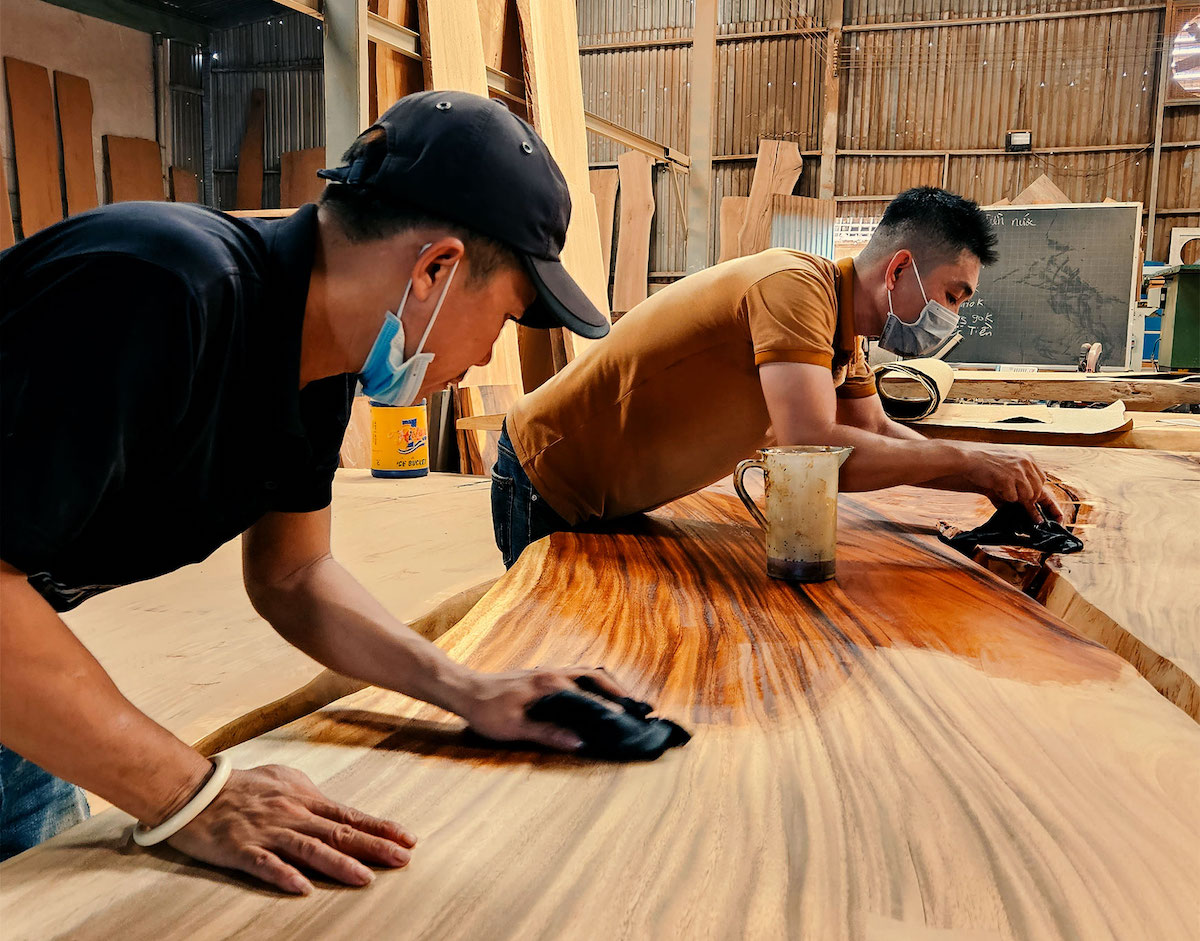Wood finishes serve the dual purpose of safeguarding wooden surfaces and enhancing their aesthetic appeal. Different types of finishes come with their own distinct characteristics and applications. In this comprehensive guide, we will delve into the world of wood finishes, highlighting their attributes and usage scenarios. Our primary focus will be on oil finishes, which are the preferred choice for live edge furniture, renowned for their natural appearance, grain enhancement, versatile color options, and other advantageous qualities such as repairability and environmental friendliness.

Lacquer Finishes
Lacquer is a quick-drying finish made from various synthetic resins dissolved in a solvent, forming a hard, glossy surface.
Applications: Ideal for furniture requiring a high-gloss, contemporary look. However, it is not suitable for outdoor use due to its vulnerability to environmental elements.
Pros:
- Quick drying time.
- Creates a hard, durable surface.
- Excellent for glossy, high-shine finishes.
Cons:
- Less natural appearance.
- Susceptible to chipping and cracking.
- Requires careful application in controlled environments.
Polyurethane Finishes
Polyurethane is a durable synthetic finish available in water-based and oil-based forms, creating a tough, protective layer on the wood.
Applications: Often used for high-traffic areas and surfaces that need superior protection, such as hardwood floors and tabletops. It comes in different sheen levels, from matte to high gloss.
Pros:
- Highly durable and resistant to moisture.
- Provides a clear, protective coating.
- Available in various sheen levels.
Cons:
- Can give wood a plastic-like appearance.
- Difficult to repair if damaged.
- Requires adequate ventilation during application.
Shellac Finishes
Shellac is a natural finish derived from resin secreted by the lac bug, dissolved in alcohol. It has a warm, amber tone.
Applications: Often used for antique furniture restoration or pieces requiring a traditional appearance. However, it’s not ideal for surfaces exposed to moisture.
Pros:
- Natural, organic finish made from resin.
- Quick drying and easy to apply.
- Can enhance the wood’s natural beauty.
Cons:
- Vulnerable to alcohol and water damage.
- Not as durable as other finishes.
- May require frequent reapplication.
Oil Finishes
Oil finishes, including linseed oil, tung oil, and Danish oil, penetrate the wood’s fibers, enhancing its natural beauty with a matte to satin sheen.
Applications: Highly favored for live edge furniture due to their ability to accentuate the wood’s grain and provide a natural appearance. Suitable for both indoor and, in some cases, outdoor use. Modern oil finishes offer a variety of color options, allowing for customization. Many oil finishes are food-safe, making them ideal for dining tables and charcuterie boards.
Pros:
- Enhances the wood’s natural beauty and grain.
- Deep penetration into the wood fibers.
- Easy to apply and repair.
- Provides a matte to satin sheen.
- Non-toxic and eco-friendly.
- Versatile color options.
- Food-safe, suitable for dining tables and charcuterie boards.
Cons:
- Requires periodic reapplication for optimal protection.
- Not as water-resistant as some other finishes.
- May darken wood slightly.
Why Oil Finishes Shine Bright for Live Edge Furniture?
Live edge furniture, celebrated for its unique and natural forms, demands a finish that complements its intrinsic beauty. Here’s why oil finishes are the top choice:
- Natural Appearance: Oil finishes enhance the wood’s natural characteristics, making it look alive. They bring out the grain patterns and colors, creating a warm, inviting ambiance.
- Versatile Color Options: Modern oil finishes come in a range of colors, allowing customers to select the perfect shade to match their preferences and interior decor.
- Non-Plasticky Feel: Unlike some other finishes, oil finishes don’t leave a plastic-like layer on the wood. This tactile quality adds to the authenticity of live edge furniture.
- Food Safety: Many oil finishes are food-safe, making them suitable for surfaces like dining tables and charcuterie boards.
- Repairability: If your live edge furniture sustains scratches or minor damage, oil finishes can be easily repaired by sanding the affected area and reapplying the oil.
- Environmental Friendliness: Many oil finishes are eco-friendly, non-toxic, and biodegradable. They don’t release harmful fumes during application, making them safer for both the environment and the person applying them.
Conclusion
When it comes to wood finishes, the choice you make can greatly impact the final appearance and performance of your furniture. For live edge pieces, where showcasing the wood’s natural allure is paramount, oil finishes reign supreme. They excel in accentuating the wood’s grain, providing a natural look, offering versatility in color, and maintaining food safety standards. Moreover, their ease of repair and environmental friendliness make them an even more appealing choice for both woodworkers and furniture enthusiasts. Whether you’re crafting or shopping for live edge furniture, oil finishes can help you achieve that perfect blend of beauty, authenticity, and functionality.
